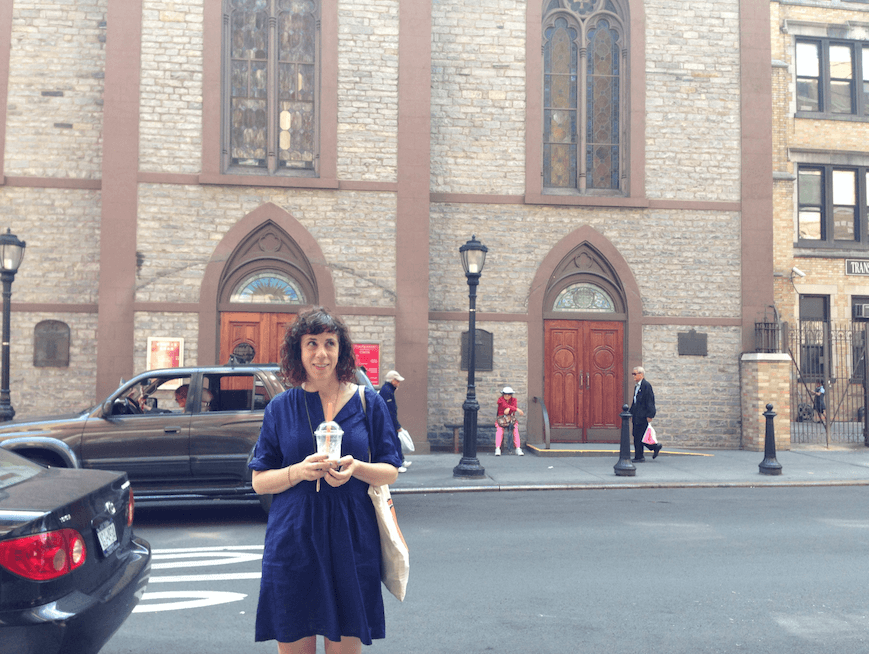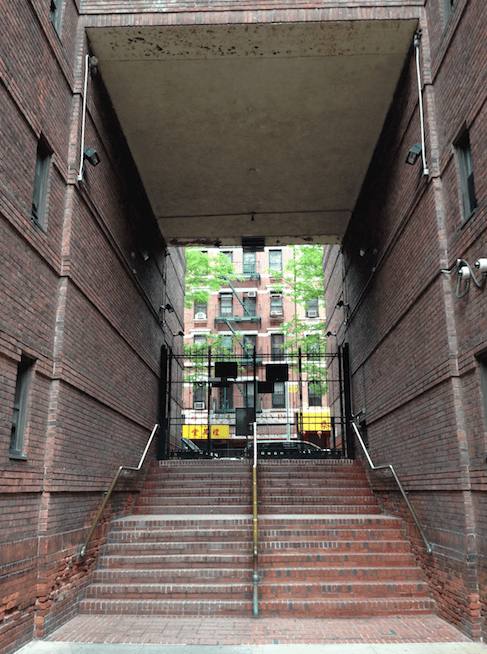Mazie’s New York: A Bowery Walking Tour with Jami Attenberg


Jami Attenberg, author of Saint Mazie
All Photos by Molly McArdle
New York Times best-selling novelist Jami Attenberg sent me a Google Maps pin to a Park Row police barricade that sat in front of the empty lot where Mazie Phillips’s movie theater—the Venice—used to be. A few days later we met there. Attenberg had gone to a book party in her celebration the night before and was, immediately following our interview, going to read at the Urban Libraries Unite 24-Hour Read-In at City Hall, where they were advocating for a restoration of funding to New York City’s libraries. (De Blasio had slashed the operational budget by 75 percent.) Then she was going to DC. Then she was going to New Hampshire. Then she was going on book tour. This is just to say that Jami Attenberg’s summer is a busy one, and I felt lucky to have her for that hot, sticky Tuesday afternoon. We were going to walk around Mazie’s New York.
Mazie Phillips, the “Queen of the Bowery,” reigned from her throne—a ticket booth out front of the Venice—from the 1920s to the 1940s. During that time she was written about by several news outlets, chief among them the New Yorker, for whom Joseph Mitchell wrote a profile in 1940. “Mazie” is collected in Mitchell’s mammoth and marvelous Up in the Old Hotel. As is Mitchell’s wont, it’s a barrage of details, all of them colorful. (Mitchell lets nothing banal about his subjects onto the page.) His Mazie is “a bossy, yellow-haired blonde” who sits “majestically in her cage like a raffish queen.” But chief among her qualities is her relationship to the homeless men who fill the Bowery’s streets. Mazie “is undoubtedly acquainted with more of them than any other person in the city.”
Restauranteur John McCormick, a friend of Attenberg’s, passed along Mitchell’s essay in 2011. He was opening a bar in Williamsburg called St. Mazie, making this famous patron of the drunk and dispossessed his own. “Instantly I thought I should write about her,” Attenberg told me. “I just knew right away.”
And so came about Saint Mazie, Attenberg’s fifth book and fourth novel, released at the beginning of June. It’s a hodgepodge of diary entries, snippets of oral history, and an unpublished autobiography. It’s also very good. Mazie, in the Mitchell profile, is larger than life. In Saint Mazie, she lives.
“When I read about her I felt like she was saying all the things I wanted to say,” said Attenberg. We were taking a bubble tea break on our walk. “She was childless and she was obviously overt about her sexuality. She was a leader of the community. She was brave. She walked the streets by herself.”
“She’s completely a feminist role model,” she said, and the novel, an “origin story for a super hero.”
From the old site of the Venice on the edge of the Bowery, Attenberg and I walked down into Two Bridges to look at Knickerbocker Village, a housing complex first built in 1934 and one-time home of Mazie Phillips. She told me about walking through the Lower East Side, thinking, at first “‘I know what this landscape is.’ Then I realized that half of these buildings weren’t there.” She started reading streets, recognizing lower buildings as older ones and looking for the few stretches of cobblestone still left in the neighborhood. Other features required imagination: the dark, dirty, and loud elevated train line that ran up Park Row, almost directly over Mazie’s ticket booth. The empty space where Mazie’s theater once was.
Looking at the streetscape, “I had to say to myself, only half of this is true. I had to erase things, squint at things.”
The space for Knickerbocker Village was cleared by razing a section of tenements called “Lung Block,” because of its high incidence of tuberculosis cases. They’re the sort of buildings Betty Smith wrote about in A Tree Grows in Brooklyn, which forever changed the neighborhood she once knew: “a place of living where sunlight and air were to be trapped, measured and weighed, and doled out so much per resident.” They are on the outside giant barren fortresses, and within, a green oasis.
Attenberg’s friend Lisa Ng (who also gave her some insight into Chinese cuisine for The Middlesteins, Attenberg’s last novel) grew up in Knickerbocker Village and was able to give her a tour of the two building’s courtyards and the underground tunnels that connected them.
“She’d tell me, ‘This is where I used to sit and hide waiting for my mom to go to work so that I could cut school.’”


We walked up into the edge of the first courtyard, where we had to stand behind a little gatehouse manned by a guard and look in. “She had never for whatever reason gone to the other building’s courtyard before. We went together and it was like an alternate universe courtyard. The birds were chirping in the first one, here they were all silent.”
She turned to me, “Cool right? There’s a different breeze coming through.”
“You can’t invent stuff like this. You have to get off your ass and go out and actually walk around. We get really trapped on our computers. It’s so easy to go, ‘I know what this building looks like because I just looked at it on Google Earth.’ But it’s right here.”
We circled the block. “There’s this cool building over here that I’ve always wanted to write about.” She hadn’t found a way to put it in an essay yet. “It’s getting easier to resist the urge to write about everything. There was a time especially when I was younger where everything was up for grabs. That’s not the case anymore. I actually just tweeted on my way here, I ran into someone I had a drug fueled affair with in the nineties. Of course I tweeted that.”
I asked about two characters, who, in the novel, ended up staying on in Knickerbocker after Mazie had moved out. Where they real?
“No, none of it is real,” she said. “You know I was going off of one Mitchell essay, but there’s an earlier Mitchell essay about her. In that one she has four brothers and four sisters. I’m so glad I didn’t find that one. That’s so many siblings. Too many siblings. I would have, like, sent them off to war, killed them off.”
“I wanted to be in the room. I needed to understand the color,” she said of the research she had done. If something from it “was going to show up it, was because it absolutely had to—like a fact—or it had to be thematically perfect. At some point I just had to start making stuff up. You just stuff your head until its overflowing.”
We rounded the northeast corner of Knickerbocker Village down towards the river and saw an open door that had “MEMBERS ONLY” painted on black block letters. “This is interesting,” Attenberg said, “This Members Only thing. There used to be mafia in this building. This might have originally been—” she paused, “—we’re going to walk by and just peek in.”
A group of older white men sat around a table wearing the sort of clothes I think you’d wear on a boat in the 70s. The walls were covered, salon-style, in framed pictures.
“That looks like what it looks like,” I said, and we turned back around.
“I didn’t want him in the book,” Attenberg said when we started talking about Joseph Mitchell again. All of Saint Mazie concerns Mazie before his 1940 profile. “There weren’t any answers in his piece. How do you go from a girl working at a movie theater to knowing every single person in the city, to being written about in the New Yorker, to devoting your entire life to helping people? You don’t come out that way.”
“I want to know how to be that way. I’m not that way, but I wanted to learn.”


We walked back up along the edge of the Manhattan Bridge. “I really had no intention of writing another New York book.” Her second book and first novel, The Kept Man, was also set in New York. “The last time I came down here, I was on the phone with my agent and said, ‘Oh I’m doing some research.’” Then it hit her. “Ah shit I wrote a New York book! Ahhh!”
We had to yell over the sound of the train passing over head. “It was not my intention at all,” Attenberg said/shouted, “but I just loved her.”
“I’ve always had an interesting relationship with it,” she said of New York. “I sort of feel like this: You know somebody for a long time, then you go out of town on vacation together, and you learn all this stuff about them that you never knew, about their childhood. Now we’re closer. I learned all this stuff. I went on vacation with New York.”
“Do you consider yourself a New York writer?” I asked.
Attenberg groaned. “Uhhhh. Nobody’s ever asked me that before.”
“Do you consider yourself a Brooklyn writer?” I groaned a little bit too here.
“Uhhhhhhhhhhhhh. That’s what they think of me as when I go to Europe.”
“New Yorkers have a really strong sense of community. Unfortunately there are a lot of people who are moving in and buying up whatever they can. A weird billionaire land grab, land rush right now. They’ve changed the city forever,” Attenberg went on. “But it’s cool, right? The city is cool. This is an incredibly diverse, energetic place. There’s nowhere else like it.”
We stopped in front of the Church of the Transfiguration, which had a statute of John Bosco—Mazie’s favorite saint—prominent on the façade. Mazie was raised in a nonreligious Jewish family, but befriended many members of the Bowery’s Catholic community during her time at the Venice. In the Mitchell, he talks about her love for this church, her friendship with nuns, her regular visits with a monsignor. In Saint Mazie, those details take root in the form of Tee, a steely, baby-faced nun who often joins forces with Mazie to help people in need.
“Everything you ever read about her,” Attenberg said, “she had a floppy hat, dangling bracelets, a walking stick. In my eye that was her superhero costume. I wanted to make sure in the book you knew how she got each item, even though nobody really cares about it. They all came from different people in her life. The cross too—it was in the Mitchell piece—I felt like that was part of her uniform.” Mazie’s cross, in the novel, came from Tee.
The church’s doors were locked. We peered in and saw group of local school children, all in uniforms, being herded into rows in front of the altar, as if they were gathering for a photo. This is when we decided to break for bubble tea.
“The problems of the city still remain,” Attenberg said after we sat down in the café across the street. “The shelter [from Mazie’s era] is still there.”
“It’s also impossible to live here right now because it’s so expensive. It’s harder for people in the arts. But as a writer it’s great place to be.” She talked about her first book deal, which came about after she met an assistant editor who helped Attenberg find an agent. “Literally I got introduced to her at a party and she changed my life forever.”
“When I teach a lot of people say, do you need to live in New York to become a writer? No. If you’re not marriage and/or you don’t have kids, if you don’t have a mortgage, go and spend a couple years in New York. See what happens. If you can, if you have that luxury, why not do it?” she said. “But you don’t have to.”


Attenberg has lived in New York since 1998. “I keep trying to leave,” she said, but hasn’t really succeeded. “It’s a good life. It took me a long time to get here. Ceaselessly hustling, ceaselessly working. But I like the work. It’s exactly what I wanted.”
We had to start walking to City Hall for Attenberg to make her scheduled start time at the Urban Librarians Unite Read-In. She had chosen to read from Mitchell’s “Mazie,” which felt like perfect storm of everything I loved. I wanted to clap I was so excited. But we were walking and Attenberg was telling me about some of the reader responses she’d already gotten—in particular from Tumblr’s Reblog Book Club.
“I am riveted by the Book Club,” she said. One reader wrote that she was glad to see a character that didn’t want to be a mother. That “was very deliberate on my part,” Attenberg went on. “She felt like she was always being forced to think about being a mother” in other books she read. It helped confirm for Attenberg that the reasons why she felt drawn to Mazie would resonate with readers. The novel “is my sincere gesture towards her.”
We cut across Columbus Park. I had just read the Wikipedia page for the Bowery that morning, which led me to read the Wikipedia page for Five Points, which led me to read that Columbus Park, this Columbus Park, stood on top of the former intersection.
“Look at you!” Attenberg said after I mentioned it. We were weaving through jungle gyms and running children. “You’ve gone on vacation with New York too!”
We walked by the Supreme Court building and a man and woman in a tux and white gown, both eating hot dogs next to the cart parked in front of the building’s big Law and Order stairs. The bride bent horizontally over her dress, so hot dog wouldn’t get on it. “I love a glimpse of a wedding,” Attenberg said, “not an entire wedding, just a little.”
After a little searching and one sidewalk dance troop, we found the tent where the Read-In was reading in. Attenberg checked in and then we hung back to wait until her turn. With The Middlesteins, she said, “it was the first time I’d had a book come out when I was really on Twitter. It was my first experience with drop-ins saying ‘Loved your book!’ and dropping out again.”
“Am I supposed to respond to all these? It was very confusing. What’s the etiquette for it? Then I just realized that any sort of recognition is great. You want to build a relationship with your readership and they’re trying to build that with you. They’re reaching out. It’s a good place to start.”
I didn’t think of it then, but reading over my notes now I’m struck a little bit by this attention Attenberg pays to relationship building, to community building. It’s a little—yes I’m saying it—Mazie-like.
“I take it really seriously, all of it,” Attenberg said. “I’m grateful for every little thing I can get. I know it can all go away.” After the success of The Middlesteins, she thought about Saint Mazie “as a responsibility to write something that people would really connect to.”
“I wanted to use that possibility,” she said. “You make people feel something, it’s the most amazing thing in the world—your words! It’s actual magic.”
Jami Attenberg‘s Saint Mazie is on sale now.
Follow Molly McArdle on twitter @mollitudo
You might also like 




















